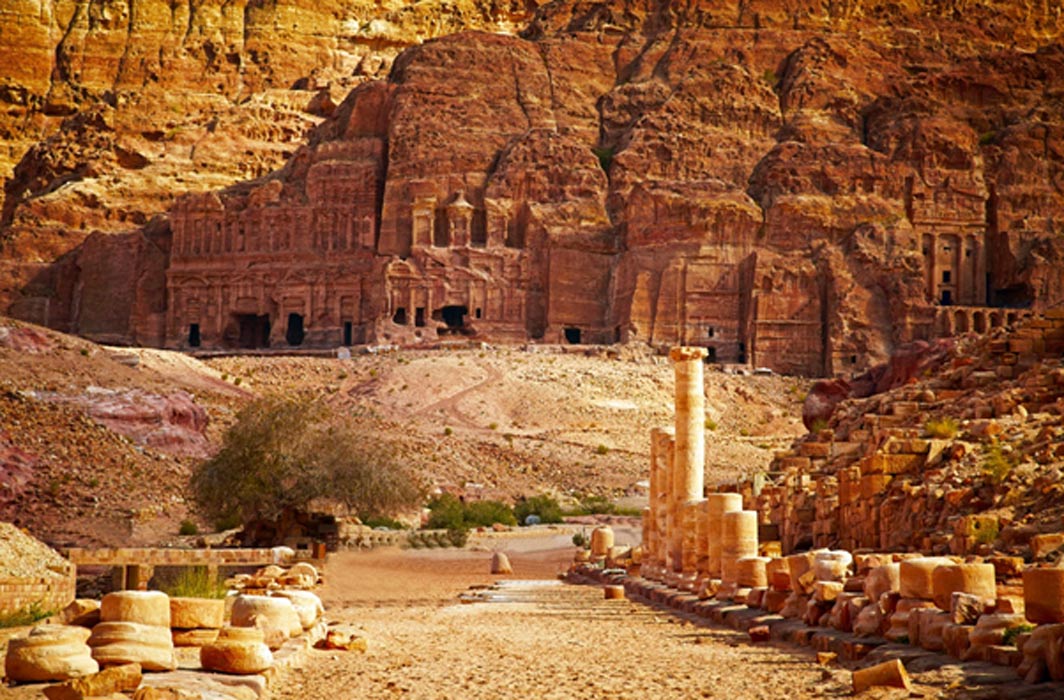BREAKING NEWS: Enormous Monument Over 2,000 Years Old Discovered in Petra
Archaeologists in Jordan have made an incredible find at the World Heritage site of Petra. A massive ceremonial platform measuring 184ft (56m) by 161ft (49m), which ‘has no parallels’ in the ancient city, was discovered just half a mile from the city center using high-tech satellite scanners.
The National Geographic reports that the discovery was made following high-resolution satellite scans, aerial drone photography and ground surveys, which identified the ancient monument hidden almost in plain sight.
“The east side of the interior platform had been lined with a row of columns that once crowned a monumental staircase,” says National Geographic. A small 28-by-28-foot (8.5-by-8.5-meter) building was centered north-south atop the interior platform and opened to the east, facing the staircase. This enormous open platform, topped with a relatively small building and approached by a monumental facade, has no known parallels to any other structure in Petra. It most likely had a public, ceremonial function, which may make it the second largest elevated, dedicated display area yet known in Petra after the Monastery.”

An overhead image of the monument photographed from a drone. Credit: Photograph by I. Labianca
Petra is a magnificent site in Jordan recognised by UNESCO for its immense historical significance and outstanding universal value. It is half-built, half-carved into the rock, and is surrounded by mountains dotted with passages and gorges. It is one of the world's most famous archaeological sites, where ancient Eastern traditions blend with Hellenistic architecture.
Petra has been inhabited since prehistoric times and is described as a Nabataean ‘caravan-city’, situated between the Red Sea and the Dead Sea. It was an important crossroads between Arabia, Egypt and Syria-Phoenicia, and has been classed as one of the new Seven Wonders of the World.
The enigmatic Nabataeans were originally a nomadic tribe, but about 2,500 years ago, they began building great settlements and cities which prospered from the first century BC to the first century AD. As well as their agricultural activities, they developed political systems, arts, engineering, astronomy, stonemasonry, and demonstrated astonishing hydraulic expertise, including the construction of wells, cisterns, and aqueducts. They expanded their trading routes, creating more than 2,000 sites in total in the areas that today are Jordan, Syria and Saudi Arabia. Archaeologists still try to unravel the history of the Nabataeans, which in large remains unknown.
- The magnificent ancient city of Petra, Jordan
- Ancient monuments of the Nabataeans were built according to celestial events
- The architectural marvel of Madain Saleh and the enigmatic Nabataean people

The magnificent ancient city of Petra, Jordan. Source: BigStockPhoto
The newly-discovered monument has not yet been excavated, but the discovery of pottery at the site suggests that the structure could be more than 2,150 years old, a time that corresponds to the Nabataeans’ initial public building program.
Along with Nabataean pottery, The Guardian reports that they also found fragments imported from the Hellenistic cultures that traded with Petra, as well as Roman-era pottery.

Overview of the monumental platform, looking south-east. Photograph: G al Faqeer
The Nabataeans built their monuments to link with astronomical phenomena. During the winter solstice, the light of the setting sun enters through the gate of the Ad Deir Monastery at Petra and illuminates the sacred motab, a podium where some stone blocks representing divinities, such as the god Dushara, are placed.
It is not known exactly what and how the newly-discovered monument was used, however, Christopher Tuttle, an archaeologist who has worked at Petra for 15 years and is a co-author of the paper, said it was probably used for “some kind of massive display function.”
“To my knowledge, we don’t have anything quite like this at Petra,” he added.
The researchers published their work in the Bulletin of the American Schools of Oriental Research.
Top image: The magnificent ancient city of Petra, Jordan. Source: BigStockPhoto


















Comments
You have no idea how ironic your comment is. If this site gets enough attention pyramids will no longer be a mystery.
Well, drone on babes but there is no way anything can be reconstructed from this image at all. Since the ground is flat-ish and whatever was there entirely razed there's no possible way anyone can state as fact that its the base of a platform upon which a seies of columns flanking stairs leads to a small building, especially as the photo here shows the alleged small building at the same level as the rest of the platform. You might as well draw a square in the sand and claim its the base of a pyramid!
Looks like a nice big landing pad when viewed from above. Did they say what the platform was made from? Massive stone blocks? Cut directly from the stone? Is it level?
picture of that platform (with arrows) is not good. I dont see a Platform. show better pics please.